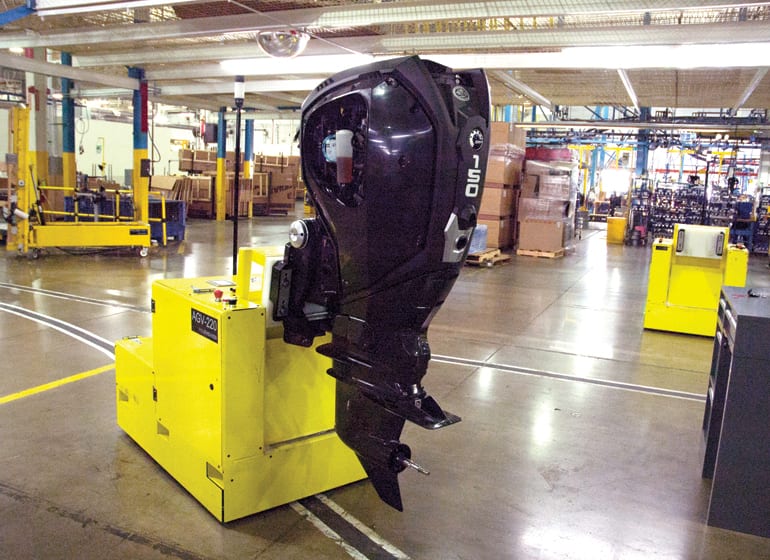Evinrude
10101 Science Drive, Sturtevant
Industry: Outboard engines
Employees: 650
evinrude.com

There are two distinct approaches to manufacturing and assembly within the Evinrude factory in Sturtevant.
The first is impressive on its own. An overhead conveyor system moves outboard engines from one station to the next. Employees check each unit in to a computer system, making sure that the proper tests have been run and the proper parts are being assembled together.
Improvements in operations over the years have improved the line’s efficiency. Subassembly processes that feed the main line use simple visual cues like an empty bin to control production volumes.
If the overhead line represents a well-oiled version of a traditional manufacturing system, the other line represents the flexibility new technologies are bringing to the industry. It is a cellular model that uses automated guided vehicles to move engines from station to station.
Unmanned carts designed by Evinrude follow black-and-white tape placed on the shop floor to move each unit through production. The flexibility allows the company to change production capacity without having to make major capital investments. It also allows a variety of different engine sizes to be made without having to change operations.
The ability to invest in advanced technologies is among the benefits Evinrude sees from being owned by Quebec-based BRP, which, as part of Bombardier Inc., bought the iconic brand out of bankruptcy in the early 2000s.
“It’s really made us better because we’re able to take global best practices and drive them into this factory,” said Nando Zucchi, vice president of marketing and international business development at Evinrude.
The parent company is also making Evinrude part of a new corporate structure with the creation of the BRP Marine Group this summer. The new segment was prompted by the acquisition of aluminum fishing boat manufacturer Alumacraft Boat Co. in June and Triton Industries Inc., maker of Manitou pontoon boats, in August.
“Ever since BRP has owned the company, we’ve been this thing you hang on the back of the boat and it pushes the boat around,” Zucchi said.
He pointed out that the nature of boating has changed significantly in recent years, with an increased emphasis on social interaction. Boating clubs are also growing in popularity, allowing people to have access to a boat for a couple weekends each year while sharing the maintenance and capital investment costs with others.
“The average price of a boat has gone up pretty dramatically, not because manufacturing costs have gone up and driven price increases, (but) because consumers are choosing more well-equipped boats, more well-appointed boats,” Zucchi said.
Digital technologies have found their way into the engine, replacing formerly mechanical processes like throttle control and automatically adjusting the position of the engine in the water. Sound systems are becoming more advanced and digital applications like fish finders are becoming more integrated. The benefit of combining engine and boat companies is a more complete understanding of the consumer.
“As an engine company, it’s hard for us to really do that; as a boat company, we’re able to really focus on that experience,” Zucchi said. “It’s making us much better at what we do, much better at understanding the consumer and the experience and less just focusing on horsepower and torque and power curves and fuel consumption curves, all of which are still critical.”
Tracy Crocker, senior vice president and general manager at Evinrude and president of the new BRP Marine Group, told BizTimes this summer the new structure could lead to operations growing in Sturtevant, but it will take time.
As the only manufacturer making primarily two-stroke engines, one of the challenges Evinrude has to overcome is being dramatically different than the competition. Zucchi said the benefits of the two-stroke platform include lower emissions, more power, more torque and an overall lighter unit.
“The biggest challenge is we’re the different guys,” he said. “We’ve chosen a different technology path and so for us that’s probably the biggest challenge, making sure people understand why we chose the path we did and why it’s a superior path.”

